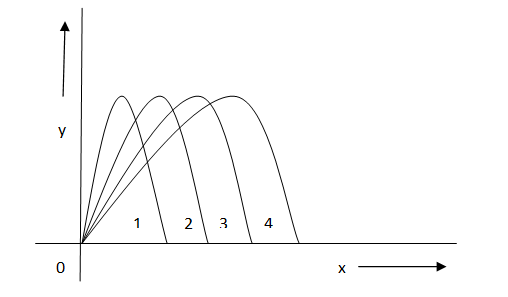
Figure shows four paths for a kicked football. Ignoring the effects of air on the flight, rank the paths according to the initial horizontal velocity component, highest first.

Answer
146.7k+ views
Hint: Kicked football forms a projected motion, therefore we define horizontal range;
Horizontal range of a projectile is the distance from the point of projection to the point where the projectile comes back to the plane of projection.
Formula for horizontal range is:
Complete step by step solution:
Let us define Horizontal range and horizontal component of velocity in detail.
It is the total horizontal distance from the point of projection to the point where the projectile comes back to the plane of projection. It is denoted by R;
In order to calculate horizontal range R, we shall consider horizontal motion of the projectile. The horizontal motion is uniform. It takes place with constant velocity of horizontal component
where time of flight is given by;
Therefore horizontal range is given by:
Component of horizontal velocity: Horizontal component of the velocity is the component of the velocity at which the velocity makes angle of projection it is given as;
In the figure of the question, the fourth path of the kicked football has the maximum range, thus the fourth path of the football has the highest component of the horizontal velocity, then third, second and first.
Note: Examples of the objects of which shows the projectile motion are: a bomb released from a level flight, a bullet fired from a gun, an arrow released from bow, a javelin thrown by athlete. In all these motions we must neglect the resistance made by air and rotation of earth and the effect due to curvature of earth.
Horizontal range of a projectile is the distance from the point of projection to the point where the projectile comes back to the plane of projection.
Formula for horizontal range is:
Complete step by step solution:
Let us define Horizontal range and horizontal component of velocity in detail.
It is the total horizontal distance from the point of projection to the point where the projectile comes back to the plane of projection. It is denoted by R;
In order to calculate horizontal range R, we shall consider horizontal motion of the projectile. The horizontal motion is uniform. It takes place with constant velocity of horizontal component
where time of flight is given by;
Therefore horizontal range is given by:
Component of horizontal velocity: Horizontal component of the velocity is the component of the velocity at which the velocity makes angle of projection it is given as;
In the figure of the question, the fourth path of the kicked football has the maximum range, thus the fourth path of the football has the highest component of the horizontal velocity, then third, second and first.
Note: Examples of the objects of which shows the projectile motion are: a bomb released from a level flight, a bullet fired from a gun, an arrow released from bow, a javelin thrown by athlete. In all these motions we must neglect the resistance made by air and rotation of earth and the effect due to curvature of earth.
Recently Updated Pages
How to find Oxidation Number - Important Concepts for JEE

How Electromagnetic Waves are Formed - Important Concepts for JEE

Electrical Resistance - Important Concepts and Tips for JEE

Average Atomic Mass - Important Concepts and Tips for JEE

Chemical Equation - Important Concepts and Tips for JEE

Concept of CP and CV of Gas - Important Concepts and Tips for JEE

Trending doubts
JEE Main 2025 Session 2: Application Form (Out), Exam Dates (Released), Eligibility, & More

JEE Main Exam Marking Scheme: Detailed Breakdown of Marks and Negative Marking

JEE Main 2025: Derivation of Equation of Trajectory in Physics

Electric Field Due to Uniformly Charged Ring for JEE Main 2025 - Formula and Derivation

JEE Main Participating Colleges 2024 - A Complete List of Top Colleges

Degree of Dissociation and Its Formula With Solved Example for JEE

Other Pages
JEE Advanced Marks vs Ranks 2025: Understanding Category-wise Qualifying Marks and Previous Year Cut-offs

JEE Advanced 2025: Dates, Registration, Syllabus, Eligibility Criteria and More

Units and Measurements Class 11 Notes: CBSE Physics Chapter 1

NCERT Solutions for Class 11 Physics Chapter 1 Units and Measurements

Motion in a Straight Line Class 11 Notes: CBSE Physics Chapter 2

JEE Advanced Weightage 2025 Chapter-Wise for Physics, Maths and Chemistry




